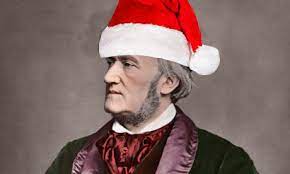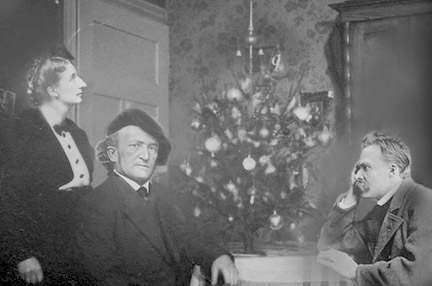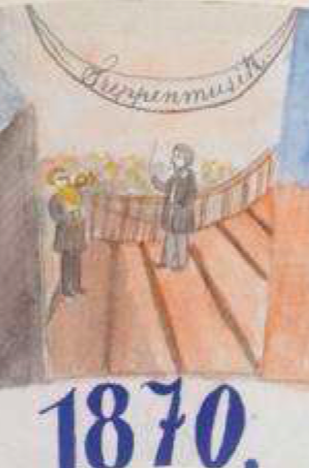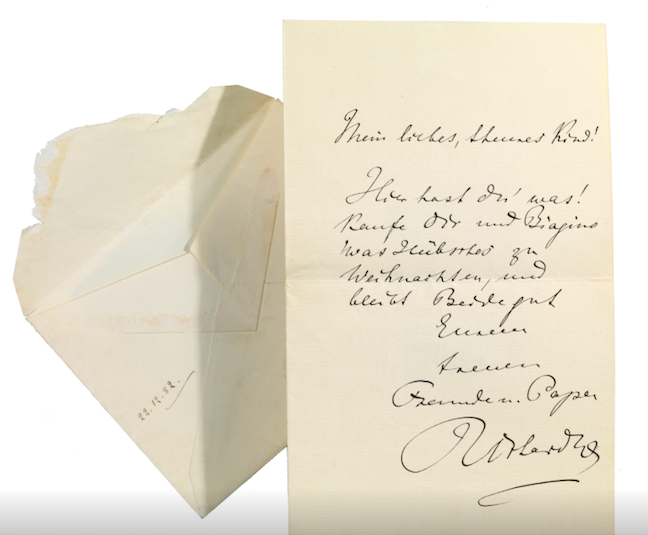
Christmas always played an important role in Richard Wagner’s life. The two women he loved most, Mathilde Wesendonck and Cosima von Bülow, both were born around Christmas, on 23 and 24 December respectively, and used to celebrate their birthdays on 25 December together with Christmas.
25 December (Christmas Day) 1830: The first premiere of a piece by Wagner - the lost Paukenschlagouverture in B-Flat major, WWV 10.
Christmas Day 1830: The Overture in D minor, WWV 20 was first performed.
Christmas Day 1857: Wagner’s Träume was for Mathilde Wesendonck (the piece itself had already been completed on 5 December.) However, Wagner wrote a second version for Christmas, scored for violin and chamber ensemble.
Christmas Day 1868: Wagner prepared a surprise Birthday-Christmas present for pregnant Cosima, Four White Songs. He selected four of the 'ancient' lieder and arranged them in an exact dramatic sequence: Christmas, the boy, expectation, snow. He revised the songs, prepared a new manuscript and bound the book himself; one song in German and three in French (Cosima’s native tongue). The first song, Der Tannenbaum is a setting of the poem of the same name by Georg Scheurlin (1802 – 1877), published in 1838. This poem has been among the most beautiful German Christmas poems for more than 150 years. It evokes the dialogue of a boy and a fir tree; the tragic fate of the Christ Child is foretold.
Christmas 1869: Friedrich Nietzsche had been invited to spend Christmas with Richard and Cosima. On Christmas Eve, he helped set up the puppet theatre, and his gift to Cosima was the dedication of his lecture on Homer (Homer and Classical Philology). 'On Christmas Day, Family lunch; afterward read Parzival with Prof. Nietzsche,' wrote Cosima in her diary.

Christmas Day 1870: Wagner composed his Siegfried-Idyll (known by the family as Tribschen Idyll) for Cosima. ‘About this day, my children, I can tell you nothing - nothing about my feelings, nothing about my mood, nothing, nothing, nothing. I shall just tell you, dryly and plainly, what happened. When I woke up I heard a sound, it grew even louder, I could no longer imagine myself in a dream, music was sounding, and what music! After it had died away, R came in to me with the five children and put into my hands the score of his Symphonic Birthday Greeting. I was in tears, but so, too, was the whole household; R had set up his orchestra on the stairs and thus consecrated our Tribschen forever! The Tribschen Idyll - thus the work is called. - At midday Dr Sulzer arrived, surely the most important of R’s friends! After breakfast the orchestra again assembled, and now once again the Idyll was heard in the lower apartment, moving us all profoundly (Countess B was also there, on my invitation); after it the Lohengrinwedding procession, Beethoven’s Septet, and, to end with, once more the work of which I shall never hear enough! - Now at last I understood all R’s working in secret, also dear Richter’s trumpet (he blazed out the Siegfried theme splendidly and had learned the trumpet especially to do it), which had won him many admonishments from me. ‘Now let me die,’ I exclaimed to R ‘It would be easier to die for me than to live for me,’ he replied. - In the evening R reads his Meistersinger to Dr Sulzer, who did not know it; and I take as much delight in it as if it were something completely new. This makes R say, ‘I wanted to read Sulzer Die Ms, and it turned into a dialogue between us two.’

Wagner and Cosima were giving no gifts that Christmas as a tribute to those still experiencing the hardships of war. Nietzsche, who had been invited again, had not been forewarned of this and arrived laden with gifts. For Wagner he had thoughtfully chosen a copy of Dürer’s great engraving The Knight, Death and the Devil, an image that since its creation in 1513 had been taken as a nationalist rallying point, a significant symbol of German faith and German courage in adversity. Wagner accepted it with great pleasure. He saw it as a picture of himself: the composer riding to the rescue of pure German culture, mounted on his “Music of the Future,” Zukunftsmusik, his nation’s true music that, he felt, had been derailed by foreign composers like Offenbach and Meyerbeer. Cosima was also delighted with her Christmas gift from Nietzsche: the manuscript of The Birth of the Tragic Concept, an early draft of the philosopher’s own The Birth of Tragedy. In the evenings, Wagner read passages aloud. Wagner and Cosima praised it as being “of the greatest value and excellence.”
Christmas Day 1871: 'Children’s games, family lunch, all happy and merry. I contemplative, as always on my birthday.' The family tradition of giving presents, celebrating, wreaths and songs was joined by Nietzsche, who had also prepared a musical gift for Cosima: Nachklang einer Sylvesternacht for piano, four hands; Cosima sight-read the piece with young Hans Richter. (However, Wagner 'could not bear to listen to the entire 15-minute-piece and had to leave the room prematurely in order to refrain from laughing out loud', as we can read in Curt Paul Janz’ Nietzsche biography.)
Christmas Day 1872: The morning began, as it had for many years, with 'birthday greetings from the children, with wreaths and singing.' In the evening, 'A children’s party, at which I show our magic lantern.'
Christmas Day 1873 in Bayreuth: 'Richard gives me the first act of Götterdämmerung, orchestrated!!!... early in the morning I hear the children in the adjoining room, singing the "Kose- und Rosenlied" (the newly composed Kinder-Katechismus zu Kosel’s (Cosima’s) Geburtstag for solo, children’s choir and orchestra Cuddles and Roses Song) so touching, so affecting! Then they come to my bedside, and Siegfried recites the poem to me!'
Richard wrote a pantomime for the children to perform on Cosima's birthday (and also did this in following years). Kinderkatechismus is one such pantomime - it's a catechism or Q&A:
The eldest girl sings
Tell me children, what blooms in May time?
The children reply
The Rose, the Rose, the Rose blooms in May.
The eldest girl then asks
Tell me children, what blooms in Christmas time?
The children reply
The cosy, the cosy, the cosy mama, the Cosima.
This ends with Brünnhilda's apotheosis from Götterdämmerung.
Christmas Day 1877: ‘Real brilliant sunshine, the first time for two months! R says to me, "Your birthday is my Sunday!" He decides on a walk with the children before lunch, we go into the palace gardens, Siegfried’s new suit, in old Germanic style, gives us much pleasure. A merry meal, R solemnly proposes my health. In the evening the history of the Arabs again, after which R reads the first 3 cantos of the Divina commedia, to our great delight; then I ask him for something from Parsifal, and he plays Gurnemanz’s narration, the entry of Parsifal - divine blessings for my birthday!’
Christmas Day 1880: Wagner’s Manuscript copy of Beethoven’s Ninth Symphony, written in 1830, was his Christmas present for Cosima.
Christmas Day 1881: Cosima received the (unfinished) Parsifal score for her birthday.
Christmas Eve 1882: To celebrate the 45th birthday of his wife Cosima, Wagner conducted a private concert for his family in the gilded Sale Apollinee, the largest room of the Teatro La Fenice in Venice. [Two days before the birthday concert, during a rehearsal, Wagner had suffered a heart attack.] The Symphony in C Major had been written when he was just 19; the score had been unearthed in a trunk the composer had left in Dresden, and he had revised it for this occasion. Wagner was able to conduct the first two movements, played by an orchestra formed by teachers and students of the music school Benedetto Marcello, before he had to ask his student and protégé Engelbert Humperdinck to take over. At Wagner’s request, Liszt - who had travelled to Venice to celebrate his daughter's birthday - played a Rossini aria at the piano.

Richard Wagner died on 13 February 1883 after suffering his final, fatal heart attack.
(Information from articles by Terence Watson, Sue Prideaux and Andrej Hoteev, and others)
